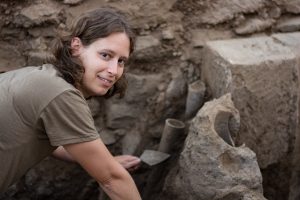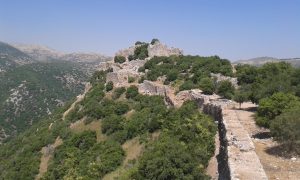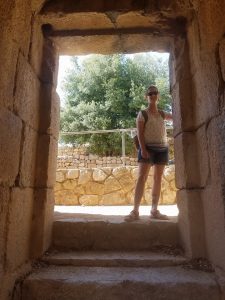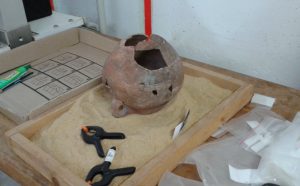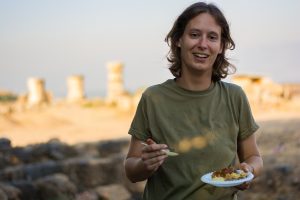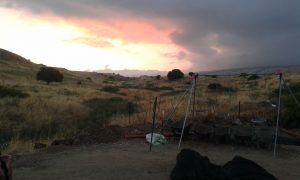
A TALE OF TWO TRENCHES … AND EVERYTHING IN BETWEEN
Emily Gray, 2017 Platt Fellowship Recipient
This summer was the final season of the Omrit Settlement Excavation Project. Thanks to the generous support of ASOR and the Platt Excavation Fellowship, I was able to participate in this compelling dig overlooking the Hula Valley in northern Israel. Every moment of hard work was well worth the effort as we sought to gain a better understanding of this site, its inhabitants, and their role in the region.
For the month of June, our crew set about exposing ancient architecture and artifacts at Omrit. Our team, consisting primarily of students and faculty from Carthage College, the College of Saint Benedict / Saint John’s University, and a few Tar Heels for good measure, explored the residential area adjacent to the Roman temple complex at the site. The Omrit settlement saw phases of construction from the late 1st century CE through Ottoman times. During the Byzantine era, the residents here began expanding into the older Roman colonnaded way that proceeds north from the temple, building walls between the towering columns to form their work and living spaces. This all rests upon the remains of an even older Roman residence dating to the late first or early second century CE, creating interesting strata ripe for exploration.
My square-mates and I had the privilege of working from one end of the colonnaded street to the other, quite literally. We first reopened and finished a square located on the far southern end, next to the temple temenos. We were continuing work from the previous season by exploring that area’s relationship to both the nearby temple and adjacent buildings along the colonnaded road. This square had the blessing of a commanding view of the temple and the valley below, a frequent breeze, and the morning shade of the only tree on site. It was here I had my first encounter with the infamous basalt “boulder.” It did not take long to figure out why people referenced these little black rocks in such a manner. A hunk of basalt smaller than a basketball feels like a task more fit for Sisyphus when you are trying to heave it over your head and out of your square. However, benefits of this activity include a rather rapid increase in upper body strength and hand-eye coordination, both necessary to keep these chunks of Mother Earth from running amok.
More importantly, this endeavor gave me great respect for the ancient craftsmen who worked at Omrit, erecting walls and shaping floors from these stones. I could barely form a decent pile, let alone a functioning structure. Soon we encountered additional evidence of these workers’ skill in the material remains of the water management infrastructure that crisscrosses Omrit. We uncovered a rather still-intact terracotta pipe, encased in concrete, that ran diagonally across our square and sliced through bedrock. I was amazed because this piping was likely sixteen centuries or more in age. Meanwhile, the water company in my hometown can hardly keep their pipes from collapsing in less than three decades (and we don’t have earthquakes). In the end, we were able to close this square out in a little over a week due to the proximity of the bedrock to the surface. While I had never before tried my hand at cleaning a giant rock surface, I believe our final square photo was well worth the effort.
Our second adventure took us to the extreme northern end of the street, where our trench became kind of a square… cubed. Our borders migrated outward as we expanded our work zone into two neighboring squares in an attempt to examine the continuity (or lack thereof) of certain architectural features. Our path was crossed with surprise floors, plastered walls, pipes, and drains. I can personally attest that these drains were well crafted, having spent a few hours contorting my body to fit into one. The bottom layers of this square³ were where we encountered remains from the earliest known residential construction on this site, the late first or early second century CE Roman residence. This building is my personal favorite at Omrit. It is such a distinctly Roman footprint on this unmistakably Near Eastern landscape. Whether it was built by a Roman official stationed here or by a member of the local elite who followed popular Roman fashions, we may never know. Regardless, this residence has the potential to illuminate interactions between the Roman Empire and locals here during this time period. We did our best to expose and examine as much of this trench as possible before time ran out. It seemed that for every question we answered in this square that we created three more; however, that is likely just testament to the wealth of valuable information that Omrit has to offer. At season’s end, our final square photo was one of a long and bumpy rectangle.
Of course, there are more educational opportunities available during field school than learning to swing a pickaxe. At Omrit, I learned to recognize the sound of a peacock’s call. I learned to kick things before I sat down them – at the same time that I learned scorpions like to hang out in things on which I like to sit. At the kibbutz that would become home, I learned the basics of reading pottery… and we all definitely learned how to wash it. Also, in the field I practiced taking Munsell readings of the varying soil. At the kibbutz, I learned this skill could also be applied to human skin tones (the sun this summer blessed me
with a 5YR 6/3). Lastly, I learned a lot during my group’s excursions to sites around Israel. These experiences were strengthened by the input of our directors and staff who accompanied us on our adventures. Especially when we visited sights interconnected with Omrit, like Banias, their detailed knowledge added great depth, illuminating what we were doing and why.
Ultimately, I am extremely grateful to ASOR and the donors who make opportunities like the Platt Excavation Fellowship possible. Without their generosity, working at Omrit would have been exceptionally difficult. This summer was everything I had hoped for and more. Because of this experience, I will eternally look forward to my next desert sunrise, trowel in hand.
Emily is currently a senior majoring in Archaeology and minoring in Anthropology at UNC-Chapel Hill. Her interests include the Near East, the Roman provinces, and zooarchaeology. She will be applying this fall to graduate programs to continue her studies.
